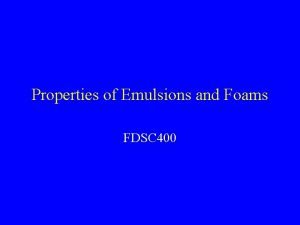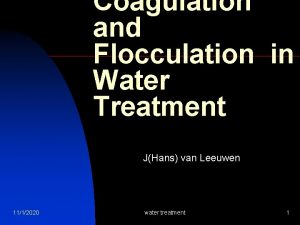DISSOLVED ORGANIC MATTER FLOCCULATION IN COASTAL STREAMS AND

- Slides: 1

DISSOLVED ORGANIC MATTER FLOCCULATION IN COASTAL STREAMS AND ITS EFFECTS ON WATER QUALITY Tessa De. Walt and Kirsten Bauer Department of Biological and Environmental Science, Longwood University RESULTS Flocculation of organic matter increased with increasing salinity. Flocculants shown in image. INTRODUCTION ● “Dead zones”, or regions of low dissolved oxygen, in coastal ecosystems are attributed to excess nutrient runoff. However, organic matter inputs may also be an important factor. ● Oxygen uptake by bacteria in response to flocculant production was investigated using water collected from two streams at Longwood’s Hull Springs Farm, Westmoreland County, VA. METHODS ● Stream water was filtered, mixed with increasing salt concentrations, and placed in air-tight bottles. ● Flocculant production and bacterial respiration were measured after a 7 -day incubation in the dark. Increased Flocculation Flocculants (mg/L) Increased Organic Matter Inputs 60 Restored Stream 50 Wetland Stream 40 30 20 10 0 0 2 5 Salinity (PSU) 13 Oxygen concentrations decreased with increasing salinity, particularly in the wetland stream treatment. Red line shows limit for most aerobic life. 10 Increased Bacterial Respiration Dissolved Oxygen Concentration (mg/L) ● When terrestrially-derived dissolved organic matter mixes with saline estuarine waters, flocculants of particulate organic matter are produced; this provides potential habitat for bacteria to more readily access carbon and nutrients. 70 Initial 9 8 7 Final Restored 6 Final Wetland 5 4 3 Two-way ANOVA: Source: P < 0. 0001 Salinity: P < 0. 003 Interaction: P = 0. 02 2 Decreased Dissolved Oxygen 0 2 5 13 Salinity Treatment (PSU) DISCUSSION Decreased Water Quality Increased organic matter to coastal streams may contribute to ‘dead zone’ formation due to its stimulation of bacterial respiration. We are currently quantifying bacterial abundance across treatments.

